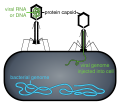Virus: Difference between revisions
No edit summary |
CSV import |
||
| Line 53: | Line 53: | ||
[[Category:Zoonoses]] | [[Category:Zoonoses]] | ||
[[Category:COVID-19]] | [[Category:COVID-19]] | ||
<gallery> | |||
File:Coronavirus. SARS-CoV-2.png|Coronavirus SARS-CoV-2 | |||
File:Hexon.svg|Hexon | |||
File:TMV structure simple.png|TMV structure simple | |||
File:Icosahedral Adenoviruses.jpg|Icosahedral Adenoviruses | |||
File:Varicella (Chickenpox) Virus PHIL 1878 lores.jpg|Varicella (Chickenpox) Virus | |||
File:CowpeaMosaicVirus3D.png|Cowpea Mosaic Virus | |||
File:Ms2capsid surface.png|Ms2 capsid surface | |||
File:Viruses-10-00497-g003.png|Viruses | |||
File:HepC replication.png|Hepatitis C replication | |||
File:Phage injecting its genome into bacteria.svg|Phage injecting its genome into bacteria | |||
File:VirusBaltimoreClassification.svg|Virus Baltimore Classification | |||
File:Viral infections and involved species.svg|Viral infections and involved species | |||
</gallery> | |||
Latest revision as of 00:53, 20 February 2025
|
|



Viruses are infectious particles composed of a nucleic acid core surrounded by a protein envelope. The nucleic acid could be RNA or DNA. They were indiscernible prior to the invention of the electron microscope since they are considerably smaller than bacteria. Viruses are ubiquitous and capable of infecting all living things, resulting in a variety of diseases.
Structure[edit]
A virus lacks internal cellular components, a cell membrane, and has a simple structure. RNA or DNA nucleic acid is located within the protein coat, commonly known as the capsid. There are millions of different varieties of viruses, but only about 5,000 have been described in detail.
Cycle de réplication[edit]
Viral life cycles vary by species, but six stages are universal:
When viral capsid proteins bind to receptors on the surface of the host cell, Attachment occurs.
- Viral entry is the process by which virions enter the host cell by receptor-mediated endocytosis or membrane fusion.
- Uncoating is the process by which the viral capsid is removed via breakdown or dissociation, thus releasing the viral nucleic acid.
- Replication involves the multiplication of viral genomes, a process that frequently necessitates the production of viral messenger RNA (mRNA) from "early" genes. Complex viruses with larger genomes may undergo one or more additional rounds of mRNA synthesis ("late" gene expression).
- After the structure-mediated self-assembly of viral particles, "'Assembly"' occurs, and proteins are commonly changed.
- Release occurs when viruses are freed from their host cell via lysis, which destroys the cell by rupturing its membrane and cell wall. Viruses that acquire an envelope from the plasma membrane of the host cell can also be discharged.
Infections by Viruses and Immunity[edit]
Viral infections in animals often elicit a immune response that eliminates the virus. Furthermore, vaccines can trigger immune responses and confer acquired immunity against specific viral diseases. Some viruses, such as HIV and viral hepatitis, are able to avoid these immune responses and cause persistent infections. Antibiotics are ineffective against viruses, but antiviral drugs are available.
Genetic Variation[edit]
The genetic architecture of viruses is more diverse than that of plants, mammals, archaea, and bacteria. A virus with either an RNA or DNA genome is designated as either a RNA virus or a DNA virus. Plant viruses normally have RNA genomes, whereas bacteriophages typically have DNA genomes.
Special Cases[edit]
Many viruses have evolved unique infection strategies. For instance, Bacteriophages have evolved to enter bacterial cells, which have a distinct cell wall structure compared to eukaryotic cell membranes. Envelope viruses, such as influenza and HIV, replicate by encapsulating themselves in a modified form of the host cell membrane, therefore obtaining an outer lipid coating that facilitates penetration.
Sub divisions[edit]
- I: dsDNA viruses
- II: ssDNA viruses
- III: dsRNA viruses
- IV: (+)ssRNA viruses
- V: (−)ssRNA viruses
- VI: ssRNA-RT viruses
- VII: dsDNA-RT viruses
|
|
|
| Baltimore (virus classification) | ||||||
|---|---|---|---|---|---|---|
|
| Microbiology: Virus | ||||||||||
|---|---|---|---|---|---|---|---|---|---|---|
|
| Life, non-cellular life, and comparable structures | ||||||
|---|---|---|---|---|---|---|
|
| Self-replicating organic structures | ||||||||||||||||||||||||||||||
|---|---|---|---|---|---|---|---|---|---|---|---|---|---|---|---|---|---|---|---|---|---|---|---|---|---|---|---|---|---|---|
|
-
Coronavirus SARS-CoV-2
-
Hexon
-
TMV structure simple
-
Icosahedral Adenoviruses
-
Varicella (Chickenpox) Virus
-
Cowpea Mosaic Virus
-
Ms2 capsid surface
-
Viruses
-
Hepatitis C replication
-
Phage injecting its genome into bacteria
-
Virus Baltimore Classification
-
Viral infections and involved species













